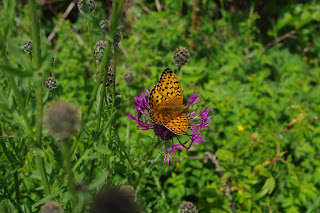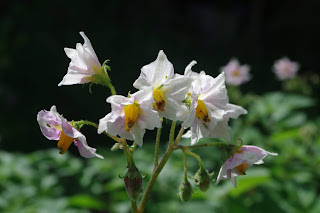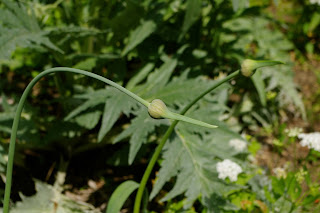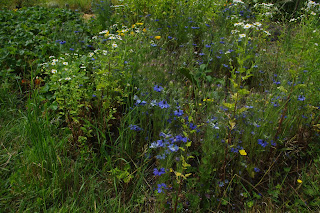A diary of back garden botany, urban ecology, rural rambles and field trips to the middle of nowhere...
Tuesday, 30 June 2020
Musk Mallow (Malva moschata) flowering prettily in the wildflower patch on the allotment. Unlike the Common Mallow mentioned several days ago M. moschata isn't very common. There is also a form with pure white flowers. Common Mallow is probably too "untidy" and prolific to be favoured by ornamental gardeners but the pink and white Musk Mallows would look fine in a sunny herbaceous border.
Monday, 29 June 2020
The profusion of butterflies has been a notable feature of my recent walks. One particular footpath was a very nice coda to my route last Thursday. I had no particular expectations other than it took me off the Chiltern Way to the village of Charlton where I could pick up a lane back into Hitchin.
The path runs between broad fields of arable monocultures for several hundred yards (generally butterfly free zones). To my delight clouds of butterflies rose up with each step I took.
I think several factors must have made this corridor so populous (there were many bees too). The hedging grows quite high on either side of the path thereby providing both shelter from the elements and combinations of sun and shade. The rows are a mixture of deciduous trees and shrubs that have not been flayed to bits, which is the fate of many hedges in the countryside.
Dog Roses and Brambles scramble through them. The way is sufficiently wide that tall grasses flourish both sides of the well trodden path and there are many wildflowers: spiky Mulleins, shaggy Knapweeds, ragged Thistles, pincushion Scabious, airy Umbellifers, frilly Bedstraws and plenty of Nettles- both the stingers and the Deadnettles.
All this seems to be very good news for the butterflies and makes me think that the concept of "wildlife corridors" has some validity.
Sunday, 28 June 2020
Friday, 26 June 2020
Thursday, 25 June 2020
Seeing so many butterflies has been one of the joys of recent walks taking in Knocking Hoe, the Pegsdon Hills and sections of the Chiltern Way. These fragments of unimproved grassland combined with pockets of light woodland, scrub and some decent hedgerows are classic habitat for butterflies and moths. Even so I think I have seen more butterflies round here than ever before. Perhaps my timing has been just right or perhaps it's the weather we've been having or a side effect of the lockdown but something seems to have made it a good year.
Wednesday, 24 June 2020
Knocking Hoe and the Pegsdon Hills have been the subject of a number of entries in recent weeks. As I have noted these survivals of "unimproved" chalk grasslands are a haven for wildflowers that have largely been lost in the surrounding countryside. From a distance the rolling slopes may seem rather sparse in terms of vegetation but the grasses are alive with tiny flowers such as Bird's-foot Trefoil (Lotus corniculatus).
Wild Thyme (Thymus polytrichus) forms mats of flowers among the blades of grass. It is aromatic and much frequented by bees, butterflies and moths. The declining populations of our pollinating insects are due to many factors but habitat loss may be the greatest threat of all. For example T. polytrichus and L. corniculatus are not only a food source for butterflies and moths on the wing they are also a larval food plant.
Here is another tiny remarkable plant: Self-heal (Prunella vulgaris). I see it everywhere: on the Pegsdon Hills and growing out of cracks between paving stones in London. I have seen it in the high mountain meadows of northern California. If I went to Asia I would find it there.
In the 16th. century the English herbalist John Gerard wrote that "there is no better wounde herbe in the world" when applied to the skin. The Cherokee ate it, Chinese herbalists used extracts for medicine.
Certain gardening books tell you that Self-heal is a weed to be eradicated from your lawn. Perhaps one day lawns will be gone along with the civilisation that tended them but Self-heal is indestructible.
Tuesday, 23 June 2020
Monday, 22 June 2020
The first leg of my walk on Saturday took me from Hitchin to the village of Pirton. This offered sweeping views across the Herfordshire countryside. From here into Bedfordshire and beyond are the open expanses of intensive farming that characterise much of East Anglia. There are wildflowers to be seen but only on the verges and field margins and in the few hedgerows and pockets of woodland that remain.
Scenic none the less. The view from the playing field of my secondary school looked across this landscape from nearby Letchworth. I used to gaze towards the far horizon- which seemed more interesting than being at school!
Sunday, 21 June 2020
This is not Bedfordshire. As mentioned in yesterday's entry I went for a walk in Herts and Beds on the occasion of the summer solstice. A very fine walk it was too but it put me in mind of a journey I made in 2016. As the longest day came to a close I boarded the Amtrak Coast Starlight at Emmeryville station in Oakland, California then traveled overnight to Dunsmuir in the far north of the state. From there I took a local bus to Shasta City (no bigger than a small town) and headed up Mount Shasta camping for several days where the trees meet the snow line.
In 1874 the pioneering naturalist John Muir said of Mount Shasta:
"When I first caught sight of it over the braided folds of the Sacramento Valley I was fifty miles away and afoot, alone, and weary. Yet all my blood turned to wine and I have not been weary since".
Saturday, 20 June 2020
Friday, 19 June 2020
Probably the top three bee plants in the garden in June by virtue of the fact that they spread freely and flower prolifically. From the top: Campanula pocharskyana, Geranium x oxonianum and Stachys sylvatica. By this point in the year trees and shrubs (not to mention houses) surrounding the garden make it quite shady but these are species that thrive in part sun/shade.
Thursday, 18 June 2020
Wednesday, 17 June 2020
Was gifted five tomato plants for the allotment but toms like a richer, more fertile soil than we have here. So I'm making a point of feeding them and the simplest, no cost way to do that is Comfrey Tea. There are various Symphytums on the allotment, notably Creeping Comfrey, White Comfrey, Common Comfrey and Russian Comfrey.
Plants need NPK i.e. nitrogen, phosphorous, potassium. Synthetic fertilisers can provide these but Comfrey leaves are an excellent source of NPK. The other consideration with these elements is that they have to be in a form that is readily available for the plants to absorb i.e. water soluble.
There is no mystery to making Comfrey Tea. Put a quantity of the leaves in a bucket then fill it up till the leaves are submerged. A lid is not essential but the resulting liquid stinks! The leaves break down entirely within a few weeks resulting in a very smelly brew.
Actually I don't wait that long. I pour it over the toms every few days (it's still pretty smelly) then top up the leaves and the liquid. I put the leaves in a basket in the bucket so they're not floating around half decomposed when I pour.
Reader, I should also point out that you have another source of well balanced NPK in a form that is already water soluble for further dilution. Moreover you have a lifetime supply, absolutely free of charge. Yes, I am referring to urine.
Tuesday, 16 June 2020
Babington's Leek (Allium ampeloprasum) is the ancestor of the cultivated vegetable. In the UK it grows on sandy and stony soil near the coast though it seems to be doing well here on the allotment.
The leeks we eat today are a biennial grown from seed. We generally eat them in the first year of growth rather than letting them flower in the second, unless we want to collect the seed. Babington's Leek is a perennial that grows from a cloved bulb. It throws up a a slender stalk whereupon a head of flowers and tiny bulbils bursts out of the spathe.
At ground level A. ampeloprasum looks similar to conventional leeks.
The stalks have a tendency to lean which is a mechanism to deposit the bulbils away from the parent plant thus increasing the spread. I believe Egyptian Walking Onions do the same thing. Walk like an Egyptian?!
This stalk seems to be gearing up to shed bulbils round corners!
Monday, 15 June 2020
Kind of blue part three. The reddish-pink buds of Viper's Bugloss (Echium vulgare) morph into deep blue flowers via exquisite intermediate tones. This is characteristic of a number of species in the Boraginaceae family. Viper's Bugloss is a biennial wildflower of chalk grasslands, coastal areas and disturbed ground. For the eco minded gardener it is regularly cited as one of the top bee plants.
As mentioned in the first of these three entries it is thought that bees may actively favour flowers of the blue-violet frequencies on the colour spectrum. Indeed there may be more to it than pigmentation alone. The journal 'Nature' published a fascinating research paper which (to quote the title) proposes that "Disorder in convergant floral nanostructures enhances signalling to bees." The researchers' findings suggest that microscopic grooves and ridges on the surface of petals can create a 'blue halo' of scattered light particles around the flower. Even on flowers that aren't blue!
Sunday, 14 June 2020
Kind of blue part two. I love the way various plants spread and self-seed in neglected beds on the allotments. Some are the weeds aka wildflowers that sprout opportunistically, others will have been deliberately cultivated in previous years then run wild finding the conditions to their liking.
Case in point the feathery foliage and sky blue flowers of Love-in-a mist (Nigella damascena) weave and wander through other blooms in a most enchanting way. The blue form is often referred to as N. damascana 'Miss Jeckyll' named for (or perhaps by) Gertrude Jeckyll.
Love-in-a-mist is an annual and packets of seed cost buttons but even that minimal expense is unnecessary here.
Saturday, 13 June 2020
Kind of blue. The flowers of Meadow Cranesbill (Geranium pratense) are white veined and translucent with an exquisite wash of pale blue-violet. Bees are said to be particularly receptive to blue hues on the colour spectrum.
I grow G. pratensis in the wildflower patch on the allotment but it's worthy of a sunny spot in any garden.
Friday, 12 June 2020
A good sweep up is a satisfying task in the garden from time to time...
A new(ish) broom swept clean the crazy paving at my father's house. As I did so a young Thrush flitted around me pecking hungrily at tasty morsels exposed by the disturbance. Activity in the garden invariably attracts the attention of birds in search of food.
Sometimes though the best thing to do for wildlife is do nothing. I was contemplating clearing out this neglected corner when I noticed bumblebees coming and going at regular intervals so there is a nest in there somewhere. Also there are hedgehogs in this garden; I have heard snuffling noises in the undergrowth around the patio when it gets dark. A few months ago I stepped out of the kitchen late one evening and a hedgehog was slurping rather noisily on the water in the cat bowl.
Thursday, 11 June 2020
Walking a section of the Chiltern Way from Knocking Hoe to the Pegsdon Hills on Tuesday I was treated to a fine display of a species I've never seen before. This is surely Wild Candytuft (Iberis amara) an annual of bare, dry, calcareous soil. Said to be fairly rare in the UK and a specialty of the Chilterns.
Wednesday, 10 June 2020
The Common Poppy (Papaver rhoeas) has been relegated to the margins of the huge prairie-like fields created by intensive farming. By that reckoning Poppies are an arable weed.
En route to the Pegsdon Hills yesterday I came across the unusual sight of a whole field of Poppies. Perhaps they are being grown as a commercial crop but it may just be that the field was ploughed then neglected. Poppy seeds can remain viable for decades in the chalky soil then germinate when the ground is turned over.
The yellow spires of Wild Mignonette (Reseda lutea) were almost as prolific as the Poppies. Likewise R. lutea is a wildflower of calcareous soils that germinates when disturbed. Poppies are an annual whereas Wild Mignonette is biennial or sometimes a short lived perennial.
And dotted among the reds and yellows were the flowers of White Campion (Silene latifolia), a common annual of hedgerows and field margins. The combination made for a spectacular blast of colour.
Subscribe to:
Comments (Atom)
















































